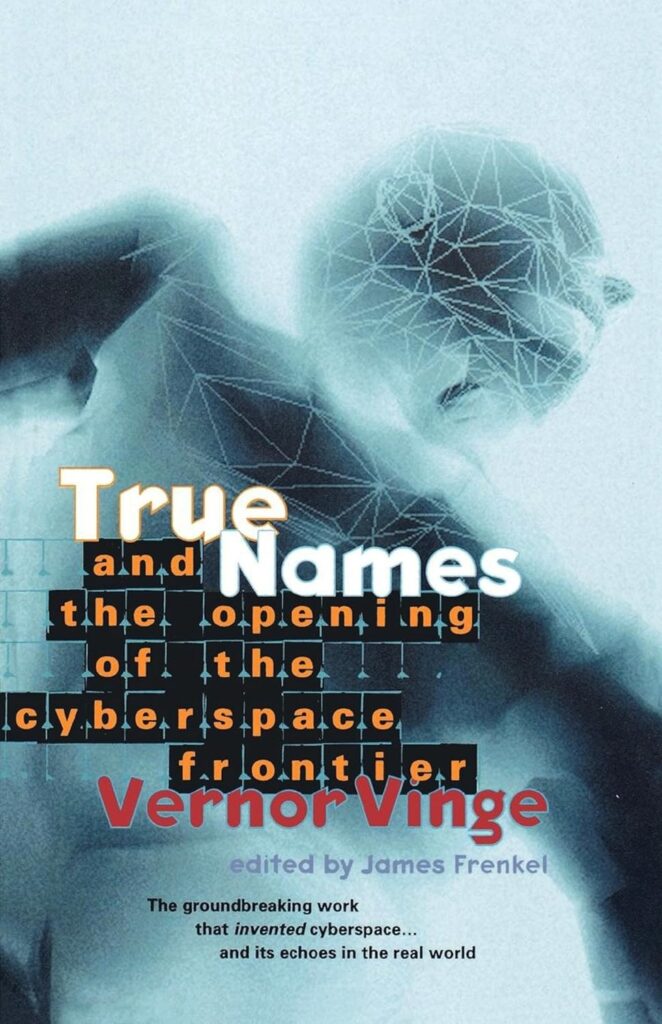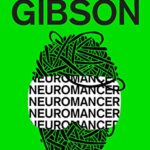The passing of Vernor Vinge, author of the great A Deepness in the Sky and A Fire Upon the Deep, led me to go back to one of his earliest ground-breaking works, the novella True Names, first published in 1981. It’s regarded as the inspiration and first detailed working out of what William Gibson would soon popularize in Neuromancer as cyberspace. I have this story in a sort of festschrift, titled True Names by Vernor Vinge and the Opening of the Cyberspace Frontier, edited by James Frenkel. It offers nine essays about various aspects of the story that explain the significance of what those authors found in this novella for the future of the computer age. That’s fine, but I just wanted to get right to the text of the story to let it speak for itself as a work of science fiction in today’s world. I think it’s a great story that is at once a fine adventure, a dazzling presentation of SF ideas and a moving human drama.
Vinge takes his title and a key part of the drama of his story from a great trope of fantasy and magic, the concept of the true name. “In the once-upon-a-time days of the First Age of Magic,” he begins, if the secret name of a magician were known, it could be used by other magicians to put them in their power and even kill them. Though the ages of reason, industry and computers seemed to do away with such ideas, the era of what Vinge calls the Other Plane brings back the meaning of true names with even greater force.
Roger Pollack, living quietly in northern California, is known as Mr. Slippery to his friends in the Other Plane, where avatars can assume any appearance they want as they seek to hack into computer systems great and small. At the outset of True Names, agents of the despised government Department of Welfare arrive at his home to coerce him into cooperating with them. This is the worst possible thing that could happen. The federal agents have learned his true name and tracked him down. They could arrest him for his transgressions or even have him killed if he has learned too many government secrets. But these agents want his help in finding the true name of a much greater threat to the computer systems of the country and the world. Known only as the Mailman, they seem to have accumulated more power through infiltrating sensitive datasets than anyone imagined possible, and they must be found at all costs.
This might sound like a conventional story line, but Vinge was writing long before the world had become as dependent on the internet as it is now. He had to work out for himself exactly how interconnected data systems would operate and what its vulnerabilities might be. He did this brilliantly, explaining in detail and with great clarity, but always in dramatic context, just what the experience of being in this Other Plane, or cyberspace, would resemble.
When Roger dons a headset, its electrodes enable his mind to process what he sees much faster, without the need to figure everything out. And all the complex processes and access to data are presented symbolically as doorways, monstrous creatures, castles, small animals. So, like the complex graphical games that would develop decades later, Mr. Slippery, or Slip, can meet his fellow warlocks of his coven, as they are referred to, each with its own garish personality and appearance. When one of the most accomplished members, Erythrina, or Ery, wants to talk with Slip privately, she guides him down the winding steps of a gloomy castle, each step, wall, and room representing her encryption programming to completely hide their communication, not only from the other warlocks but also from the government and other sophisticated users.
Later in the story, when Ery and Slip are battling forces marshaled by the Mailman, essentially for control of the world, they attain a level of data access they had not imagined possible.
“…they were experiencing what no human had ever known before, a sensory bandwidth thousands of times normal. For seconds that seemed without end, their minds were filled with a jumble verging on pain, data that was not information and information that was not knowledge. To hear ten million simultaneous phone conversations, to see the continent’s entire video output, should have been a white noise. Instead it was a tidal wave of detail rammed through the tiny aperture of their minds. The pain increased, and Mr. Slippery panicked. This could be the True Death, some kind of sensory burnout —“
True Names by Vernor Vinge and the Opening of the Cyberspace Frontier, edited by James Frenkel, Tor, 2001, paperback edition, page 285
When this war against the Mailman is over, Roger and Ery feel permanently changed. They came close to being like gods, able to manipulate almost any real-world activity or institution, but relinquished that great power. In the aftermath, they feel reduced, but Roger becomes obsessed with meeting the “real” Ery behind her startlingly beautiful avatar. Vinge has him getting caught up, even against his better judgment, in fantasizing about her, and in that imaginative trend captures the very human need to go behind the masks of online interaction. While this story is not strong on character, the final scene in which Roger and the real Ery meet is a very moving one and offers a fine ending to a powerful adventure and mystery.
The novella also straddles the fine line between fantasy and science fiction in two ways. First, it takes the true name trope directly from the world of fantasy fiction, but more importantly it brings out the way in which the human characters get to act out their wildest dreams in this new realm. While Vinge keeps the focus on the realities underlying their representations online, he builds a story of fantasy adventure that overlays that scientific substructure. He also describes quite well the human cost and real-world implications of what is experienced as fantasy while the characters are immersed in the Other Plane. I may be wrong, but I think this was the first time such a dual-level of experience was incorporated into science fiction in just this way.
True Names is both a pioneering work and an exciting story to read. Vinge was much more sensitive to the changing views of women and diverse physical traits, so I never had that wincing feeling I often get when reading the earlier generation of Heinlein, Asimov and company. The story is a fine introduction to the work of a great science fiction writer who, unfortunately, seems to get a little less attention than he deserves.




Leave a Reply